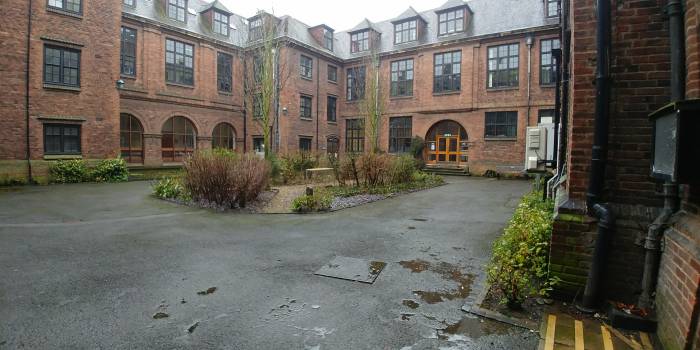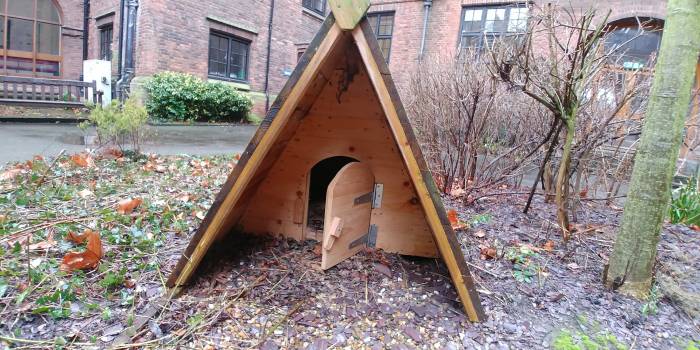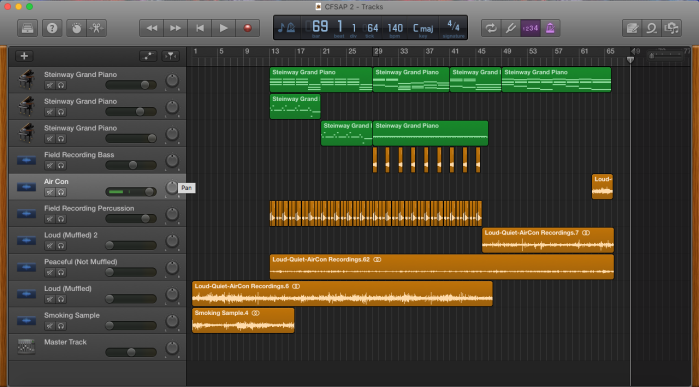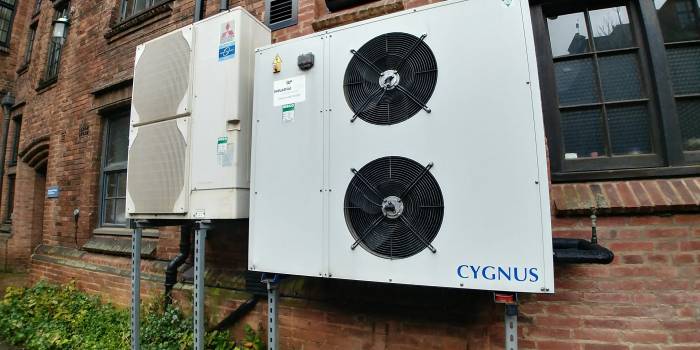This weeks task entailed composing for any space or place off campus in Hull. Following on from some feedback I received about my compositions the last two weeks about the Cohen Courtyard, I decided to take a completely different approach to this task. The last two tasks have seen me composing a piece using the space as the main element and incorporating lots of field recordings. I have composed for how the space makes me feel and the possible situations that might occur within the space. For this task, I decided to compose the piece so that it could not be performed at any other time or place because of the elements of the space it utilises. I had set myself quite a challenge with the idea I had and it started off by doing a lot of field research.
A group of us took a quick road trip into Hull city centre and explored some of the spaces around Queen Elizabeth Gardens, Old Town, and The Marina. We looked at a few of the lakes and art installations in the Queen Elizabeth Gardens and I had thought about using a water tap there as the basis for a piece. However, the rest of the space did not give me much inspiration to bloom ideas for a composition. As we walked around Old Town we passed Hull Trinity Church which has a beautiful, open space with a wonderfully reflective natural reverb contained within it. There was a lot of scope to explore the capabilities of a piece being performed in the space outside the front of the church, however, the space around it was again uninspiring for me. The last place we visited was The Marina and Humber Street. As we walked down past the Humber Dock Bar & Grill and 1884, we noticed the subtle clanging of the ropes on the masts of the boats moored up in the Marina. It made a very interesting sound and we began to explore the possibilities of responding to this sound with different instruments. However, finding instruments and compositional ideas that would suit this was proving difficult and the fact that it was windy meant we couldn’t hear any of the masts too well. We figured that for the piece to work it would need to be windy for the ropes to move and hit the masts so the idea had a slight flaw in it. We continued around the marina and looked at the lock as well and walked around past the deep and continued back to the city centre. Overall, for me, I felt as if there were more interesting locations in Hull that I could compose for.
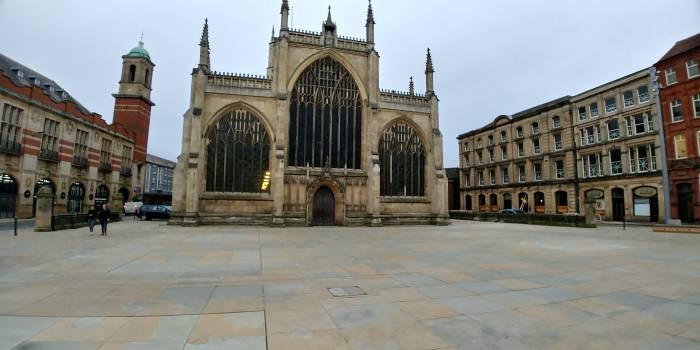
The next day I drove down to the train crossings and visited Cottingham Train Station. I had a very vivid idea of extracts that would get triggered by the crossings and the trains. This slowly evolved into a much more complex piece once I had visited the place and seen how the crossings worked.
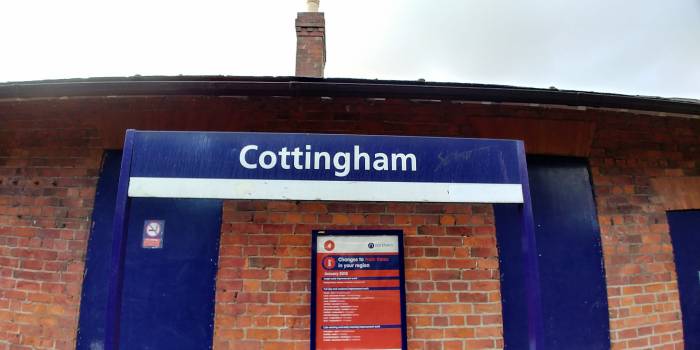
I initiated the thoughts for my composition by deciding that I would use both of the crossings immediately north and immediately south of the train station to trigger extracts that would be played by musicians strategically placed in the area. I would have 3 groups of musicians: one placed at the North crossing; one placed at the train station itself and one placed and the South crossing. For the crossings, there would be a pair of musicians on two different instruments responding to the sounds around them whilst they followed a free-form score with one musician on each side of the crossing. For the train station, I would have 3 musicians: one on platform 1; one on platform 2 and one on the footbridge. I decided to accompany most of the descriptions in this particular post with sketches that help create a visual image of what the descriptions would look like. The most important elements of each sketch are in red.
The next question that came to my mind was, ‘how are people going to watch this piece?’. My concluding thought was that the audience would sit on the trains as they passed through these 3 locations. After some thought, I figured that the audience would not be able to hear the musicians with the noise of the train and the windows closed. After a fair bit of research, I decided that placing microphones on top of the train and on the four corners of the train too would be the way to ensure the audience heard the composition in the best possible way. I would then live stream these microphones to headsets given to the audience members at the beginning of the piece so they would be listening to what is happening outside the train in real time. Using something like a Neumann U87 would be ideal as this has an omnidirectional setting, for placement on top of the train, and a cardioid setting, for placement on the corners of the train. It is a very versatile microphone with a lot of capabilities and using the same microphone would mean that the sound being live streamed to the headsets would be of equal quality.
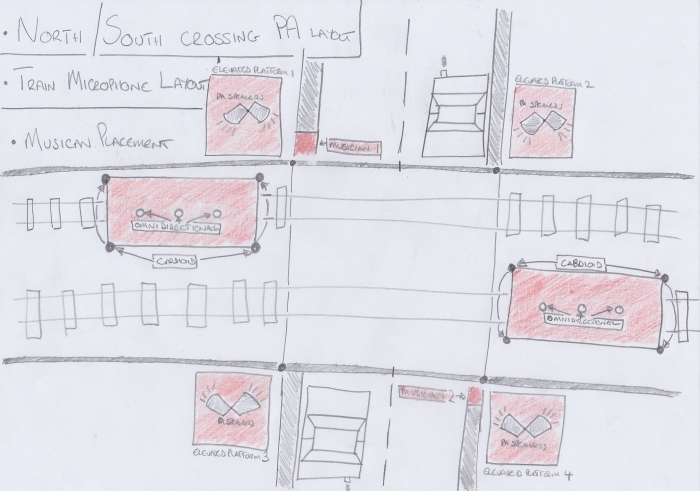
After deciding this, I went on to choosing the instrumentation for my piece. I originally decided on Electric Guitar played with an E-Bow and Trombone for the crossing pairs as I figured the juxtaposition of electronic and brass would work nicely together. However, after considering the sort of sustain value I needed my instruments to have, I changed the Trombone to an Electric Guitar played by an E-Bow as well, so the two instruments can respond to each other in a similar way. With the crossing instrumentation being electronically based, it meant I had to find a way of amplifying it. My thought was that I would have 4 small stage platforms positioned on each of the 4 corners of the railway crossings. There would be one north and one south facing PA speaker on it, placed at 45˚ angles so that it would be at the same level as the train and be covering all directions.
That would make sure the crossing instrumentation was audible and as for the instrumentation based at the station, I decided to go for a trio of cellos. One on the footbridge, one on platform one and one on platform two. The idea was that they could imitate the drone of the engine whilst the train was stationary at the station. The reason for 3 cellos was so that the audience could hear the extract from all angles.
Working out when the instruments would play was my next hurdle. I went down to the train station and assessed the timetable and found that there were 4 trains passing through, 2 on each platform, between the time of 17:30 and 18:15. I decided that I would then write 4 extracts for the crossing pairs and 1 extract for the cellos at the station. I tried to time how long the trains stopped for and how long each crossing when down for over 45 minutes and every time I timed it, it turned out different. One crossing went down for 2:11 then 2:13 and the other went down for 2:30 and then 2:34 and the trains stopped for 0:43 then 0:54. It ended up becoming too complicated for me to write extracts that were a specific length for the musicians to play. I decided the piece had to flow more freely with the musicians starting to play when the crossing gates began coming down and finishing playing when the crossing gates have gone up fully again. For the cellos, it was when the train had come to a complete standstill that they started fading in their instruments and when the train began to move again that they would start fading out their instruments.
The next thing on my list was attempting to explain to myself the concept of this whole piece. Effectively there are two audiences. The first audience starts in Beverley whilst the second starts in Hull. The first audience arrives in Cottingham at 17:38 having heard extract 1 on their way through the North crossing. They will then hear extract 2 on their way through the South crossing. The second audience arrives in Cottingham at 17:46 having heard extract 1 on their way through the South crossing. They will then hear extract 2 on their way through the North crossing.
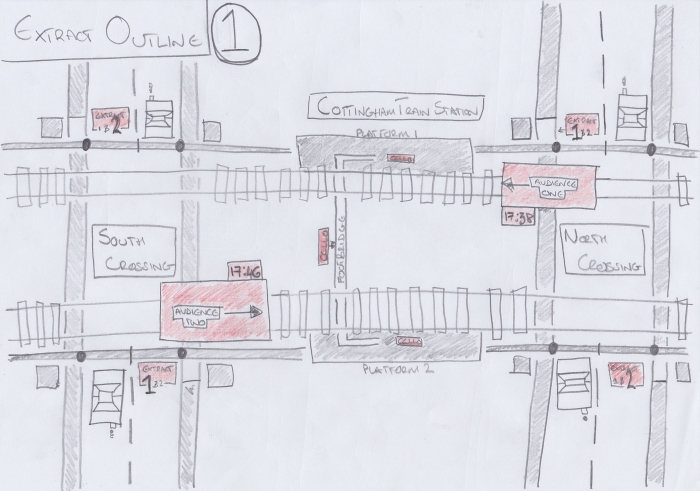
Following their departure from Cottingham, audience one will arrive into Hull at 17:48, disembark, then re-embark on the 17:59 towards Cottingham again. They will then arrive at Cottingham at 18:07 having heard extract 3 on their way through the South crossing. They will then hear extract 4 at the North crossing before they arrive at Beverley to disembark at 18:13. Audience two will arrive into Beverley at 17:52, disembark, then re-embark on the 18:07 towards Cottingham again. They will then arrive at Cottingham at 18:13 having heard extract 3 on their way through the North crossing. They will then hear extract 4 at the South crossing before they arrive at Hull to disembark at 18:23. Additionally, every time both audiences come to a standstill at Cottingham Train Station, they will hear the drone of the cellos.
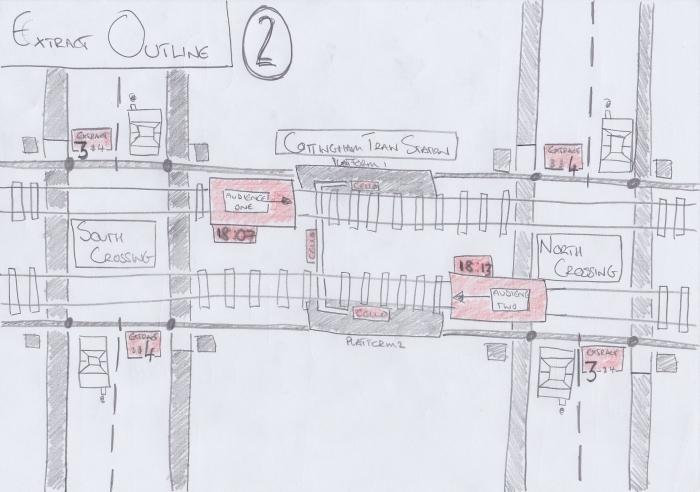
This means there are multiple ways to hear the pieces as audience one will hear extracts 1 and 4 at the North crossing and extracts 2 and 3 at the South crossing with audience two hearing the opposite. In addition to this, the audiences will pass each other and pick up the sounds of the passing audiences which will be incorporated into this composition alongside the sounds of the nature around them. For the crossing musicians, they will not have to repeat any extract more than once. This is because any extract they do not play to one of the audiences, the other pair of musicians will have played that to them instead and vice versa.
For the actual piece, I decided to write it on manuscript paper but write a set of rules for each score too. For the guitar, I figured it was best to keep the actual notation simple. I wrote 4 extracts, with octave variations for the second guitar, and two extracts for both guitars to play identically when the barriers are coming down and going up.
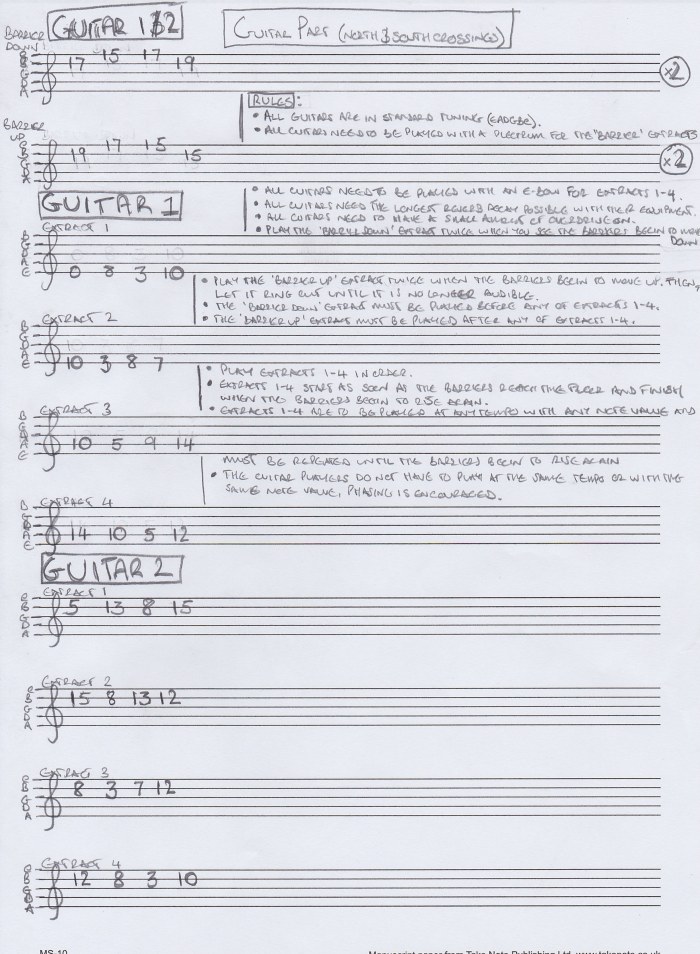
The extracts effectively come in two pairs because extracts 1 and 2 will be played in relatively close succession due to the proximity of the crossings to the train station. I wrote extract one and it sounded kind of dark and mysterious, I think reversed and it sounded more positive. I decided to have this sort of reflection with extracts 3 and 4 and the Up & Down extracts as well. I felt like having something less uplifting when the train is coming to a stop or the barriers are preventing vehicles from moving represented the fact that there is something stopping you from going somewhere which can be frustrating and annoying. When the train is starting to move again and the barriers reopen, the positive extract represents the fact that you can be on your way to where you want to be again, it makes you feel better.
I decided that the guitar parts should also be very free and open to interpretation. I want the musicians to be able to choose a tempo and note values based on the environment around them. Base what they are playing on what they can see and hear at the specific time and respond to the environment and even their fellow guitar players to create a call and response and some dramaticism within the piece. the list of rules for both the cellos and guitars are below.
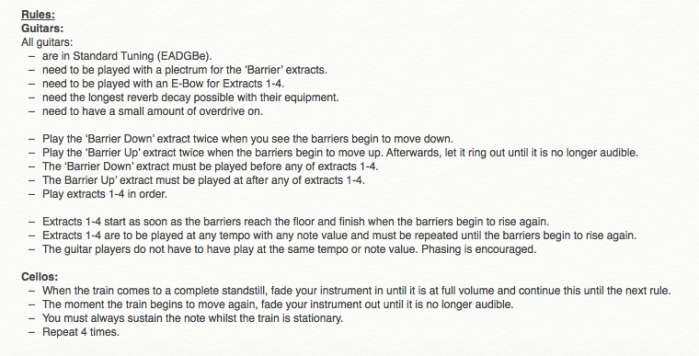
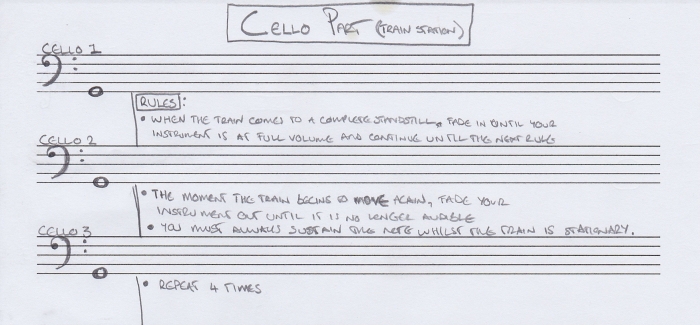
For the cello, it was pretty simple to notate. I chose a pitch for all three cellos that I felt represented the sound of a stationary train engine the most. I then wrote a few simple rules about when they should come in, when they should drop out and what they should be playing whilst the train is stationary and that completed the score for the cellos. A lot of the influence for the way it sounds and the way it was written was from some of the soundscape material from Oliver Coates that I came across last year.
This pretty much concludes the writing of this piece. It is quite an intricately crafted one with a lot of moving parts and a lot of reliance on nature, the space itself and the things that pass through it. As for the name, I wasn’t entirely sure what to call it. I could have just called it ‘Cottingham Train Station’ but I felt like that was a little mundane. I eventually decided on ‘Phasing Is Encouraged’. I wrote this down on the end of the guitar rules and it just sounded like the sort of thing that represented the whole free-flowing nature of this piece and its reliance on its environment This has definitely been one of the most challenging compositions I have written but it was a lot of fun to work on too.





